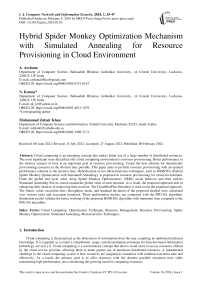Hybrid Spider Monkey Optimization Mechanism with Simulated Annealing for Resource Provisioning in Cloud Environment
Автор: A. Archana, N. Kumar, Mohammad Zubair Khan
Журнал: International Journal of Computer Network and Information Security @ijcnis
Статья в выпуске: 1 vol.16, 2024 года.
Бесплатный доступ
Cloud computing is an emerging concept that makes better use of a large number of distributed resources. The most significant issue that affects the cloud computing environment is resource provisioning. Better performance in the shortest amount of time is an important goal in resource provisioning. Create the best solution for dynamically provisioning resources in the shortest time possible. This paper aims to perform resource provisioning with an optimal performance solution in the shortest time. Hybridization of two Meta-heuristics techniques, such as HSMOSA (Hybrid Spider Monkey Optimization with Simulated Annealing), is proposed in resource provisioning for cloud environment. Finds the global and local value using Spider Monkey Optimization's (SMO) social behavior and then utilizes Simulated Annealing (SA) to search around the global value in each iteration. As a result, the proposed approach aids in enhancing their chances of improving their position. The CloudSimPlus Simulator is used to test the proposed approach. The fitness value, execution time, throughput, mean, and standard deviation of the proposed method were calculated over various tasks and execution iterations. These performance metrics are compared with the PSO-SA algorithm. Simulation results validate the better working of the proposed HSMOSA algorithm with minimum time compared to the PSO-SA algorithm.
Cloud Computing, Optimization Technique, Resource Management, Resource Provisioning, Spider Monkey Optimization, Simulated Annealing, Meta-heuristics Techniques
Короткий адрес: https://sciup.org/15018819
IDR: 15018819 | DOI: 10.5815/ijcnis.2024.01.03
Текст научной статьи Hybrid Spider Monkey Optimization Mechanism with Simulated Annealing for Resource Provisioning in Cloud Environment
Cloud computing is characterized as the abstraction of information from the user, requiring no additional technical knowledge. It is regarded as a creative complement, usage, and dissemination prototype for Internet-based information technology services [1]. Cloud computing is a revolutionary concept that allows cloud users to access resources offered by the cloud service provider, allowing them to make greater use of numerous distributed resources. A fundamental challenge in the cloud computing system is how resources are assigned to customers with minimal execution time and effectively. As a result, the primary goal is to offer resources with the shortest possible execution time while maintaining high performance, also considering the growing need for computing resources.
The mechanism for provisioning resources in a cloud environment is called resource provisioning. It carries out provisioning in accordance with client demands. Both options are available to customers who wish to pay a bill in advance for needed resources or a bill based on actual consumption. The main aspect to look out for a while executing resource provisioning is to prevent over and under-provisioning of resources. Under provisioning refers to resources supplied to customers that are insufficient for their needs, whereas over-provisioning refers to resources that are excessive and not needed by users [2, 3]. Therefore, it's important to deliver resources on time and in accordance with user needs in order to ensure efficient resource provisioning.
This paper aims to provide a hybrid HSMOSA strategy to ensure effective resource provisioning. This is a hybridization of simulated annealing with spider monkey optimization. In their respective fields, simulated annealing and spider monkey optimization are both significantly beneficial. As a result, we assessed the features of both methods and produced HSMOSA, a hybrid algorithm that increases throughput and efficiently allocates resources with minimum processing time. Comparison with the current PSO-SA method is also included to show the effectiveness of the proposed methodology. This PSO-SA is an existing hybrid resource provisioning strategy [4]. Following are the main goals of this paper:
• To minimize the execution or provisioning time of resources.
• To optimize the fitness value of task, this leads to improve their position.
• To increase the throughput and improve the performance of allocating resources.
• To address the resource provisioning problems of over and under-provisioning.
• To perform the better provisioning of resources as compared to the existing method.
2. Related Works
Improve the overall efficiency of resource providing by accomplishing the aforementioned objectives. This facilitates improved resource provisioning in a cloud environment. Simulation data are presented to explain how the suggested HSMOSA technique performs in a cloud environment. The next section shows the literature review related to resource provisioning and meta-heuristics technique.
Swarm intelligence encompasses a variety of optimization strategies, including SMO, a recently population-based technique employed on spider monkey group interactions. It is derived from spider monkeys' foraging intelligence behavior, reflecting the fission-fusion social system (FFSS). Individuals in FFSS form temporary small groups whose individuals are members of a larger or more stable created and popular technique that has established its place among the group of optimization techniques. SMO is society. Monkeys partition themselves into groups based on the lack of available food sources. These groups may be larger and smaller. The global leader is considered the leader of the entire group, and a local leader is assigned to smaller groups. Spider monkey optimization includes six phases [5], which are as follows:
-
• Local leader phase: All spider monkeys can update themselves at this phase. The fitness value of each spider monkey is used to generate a new position. If each spider monkey's newly determined fitness value is better than the previous fitness value, the position should be updated; otherwise, it should not.
-
• Global leader phase: The solution is updated based on the fitness function and probability in this phase. Use the greedy strategy to identify the best value and update the solution.
-
• Global leader learning phase: In this phase, compare the improved fitness value to determine the global leader from the complete solution. If the global leader's position is not changed, the global limit count is increased by one. Set 0 otherwise.
-
• Local leader learning phase: This phase is very similar to the one before it. Increase the global count if the local leader's position has not been refreshed; otherwise, set 0.
-
• Local leader decision phase: This is essentially a choosing phase to use the local limit counter and, if necessary, re-initialize the local leader if there is any early convergence in the group.
-
• Global leader decision phase: To avoid premature population convergence, the global leader must make a vital decision at this phase. If required, split the population into groups and then reunite in the end.
Simulated annealing is based on the general annealing idea, in which a system is slowly cooled until it reaches a minimal energy state where it is vital. This approach performs better when dealing with optimization problems because it involves annealing. The objective function was also employed to optimize the solution in this approach. It begins at T, the starting temperature. Then calculate a new solution and compare it to the previous one; if the new solution has a lower value than the previous one, accept it. If the new solution has the highest value, perform an exponential calculation and generate a random number. Accept the new solution if the random number is smaller than exponential; otherwise, reject it.
expon = e(-∆f/T) (1)
∆f=change value of an objective function
T represents the temperature.
In the SA procedure, randomly generate an initial solution.
The system's temperature significantly influences the actual annealing process's temperature.
In SA, most worsening moves may be picked in the beginning, but only improving moves are allowed at the end [6, 7].
To address the allocating issue of cloud services, an autonomous resource provisioning and scheduling architecture were proposed. The multi-objective optimization problem was solved by combining the spider monkey optimization algorithm with this framework. The efficiency of this scheduling system was demonstrated via simulation results [8]. In virtualized cloud data centers for service providers and users, a novel strategy is developed to help minimize energy costs and optimize revenue. A proposed smart controller achieves fine-grained resource provisioning. Furthermore, a novel hybridization of particle swarm optimization with simulated annealing [9] is used to address the profit maximization problem. An ePower mechanism is introduced to improve the system throughput and manage power consumption regarding green power supply [10].
The suggested cloud Assisted Mobile Edge (CAME) virtualization technology boosts the edge platform's scalability. The proposed optimal resource provisioning (ORP) scheme with various instances improves the edge hosts' processing power [11]. ElasticNFV is suggested for Virtual Network Functions. Its two-phase minimal migration technique reduces migration time and VNF embedding cost minimization [12]. A TIMER-Cloud framework is suggested to prioritize user requests according to their resource needs and deadlines [13]. An extensive survey is offered to identifying significant research challenges and real-time computing paradigms [14]. An AFSMO method was designed to address the Spider Monkey Optimization technique's stagnation and slow convergence concerns. This AFSMO approach featured an accelerative component that improved the core SMO algorithm's global and local leader phases [15]. The electromagnetic and antenna communities employed spider monkey optimization. To demonstrate the SMO algorithm's value, it was compared to other traditional optimization methodologies [16]. To solve the multilevel planning and scheduling problem, the HSMO method is introduced for parallel PCB assembly lines. According to the experiment results, the HSMO methodology can produce a better optimal solution than other traditional methods [17].
A spider monkey crow optimization strategy based on a sentiment categorization form is presented toward deep recurrent neural network training. It essentially employs telecom review to reduce user searching time by eliminating step words and excluding extraneous information [18, 19]. SMDs have been shown to use less overall energy using a partial compute offloading scheme (Smart mobile devices). A novel hybrid meta-heuristics paradigm is used to resolve non-linear constrained optimization [20]. The suggested green cloud computing paradigm separates the problem of virtual machine deployment from the issue of job scheduling. A CESCC approach is presented to forecast the potential workloads of the system. According to the experiment findings, prediction enhances real-time response efficiency and system stability, and conservative control procedures catch up with resource pre-allocation demands [21]. To reduce total makespan and cost of multiple-workflow scheduling, an MCHO mechanism is offered. Initially, a multi-swarm co-evolutionary process was built, with three swarms searching for various elite answers. Second, it includes local and global guiding information from particle swarm optimization to increase global search and convergence performance. Finally, to use more non-dominated individuals, a genetic algorithm-based elite augmentation strategy has been devised [22]. Added probabilistic sampling of simulated annealing to the PSO algorithm to improve the PSO-SA algorithm's limitation. It aids in maintaining population diversity and avoiding falling into the optimal local solution [23].
To address service discontinuity in mobile edge computing, an effective edge intelligent service placement algorithm (EIPSA) is presented [24]. To manage and overcome premature convergence of resource allocation in mobile edge clouds, an FSAOS (fruit fly-based simulated annealing optimization strategy) has been developed. The usefulness of the FSAOS approach was demonstrated in this global and local search balance utilizing simulated annealing EdgeCloudSim simulation results [25]. Exponentially spider Monkey optimization (E-SMO) is presented for effective resource allocation to reduce power consumption and improve service quality. It's a spider monkey optimization paired with an exponential weighted moving average [26]. By lowering the number of integrated web services, the Multi-Stage Forward Search (MSF) method is used to improve the processes of web service selection and composition. This model employs the spider monkey optimization technique to improve services. Experimental results demonstrated that the suggested SMO method outperformed the innovative multistage forward search technique [27]. The importance of the simulated annealing method in the traveling salesman problem is discussed to determine the best route between items. The primary objective is to use mathematical models to identify the shortest path between the various items [28].
3. Proposed Hybrid Algorithm (HSMOSA)
To correctly provision resources in a cloud context, proposed the HSMOSA hybrid approach, which integrates Spider Monkey Optimization with the Simulated Annealing algorithm. This work used SMO to search local and global, and SA to search around global best after finding global and local best. Let's look at it another way, local best and global best have a better chance of increasing fitness value. This hybrid approach can help solve the local and global value stagnation problem in the SMO algorithm if it occurs during the process and overcome the limitations of the simulated annealing and spider monkey optimization algorithms along with a better fitness solution. The proposed algorithm's primary objective is to provide efficient resource provisioning with the optimal solution in the least time possible while increasing throughput. In addition, this proposed algorithm is compared to the PSO-SA method to demonstrate that the proposed algorithm has a more significant impact on resource provisioning.
Mathematical formulation
The proposed HSMOSA algorithm's problem and mathematical formulation for resource provisioning in the cloud environment are as follows. According to equations (2, 3, 4, 5, and 6), the local and global leaders are searched. After finding the global and local leader, applies the simulated annealing concept to search around the global best (VMs or hosts) and give maximum chance to update their position and find the optimal fitness value at each iteration. For this purpose, Eq. (7, 8) is considered.
-
3.1. For Local Leader Search
-
3.2. For Global Leader Search
SM nPos(i,j) = SM ij + rd(0,1) ∗ (LLpos rj - SM ij ) + rd(-1,1) ∗ (SMrd i,j - SM ij ) (2)
Where SMij is the SM's jth dimension. The jth dimension of the rth group's local leader is represented byLLposrj , SMrdi, j represents the jth dimension of a randomly picked SM from the rth group is represented bySMrdi, j , and rd is the range of uniformly selected random numbers.
objective function = (d + 1) ∗ xd4(De john's f4)
1 , if ft i ≥ 0
fitfunction = fitnessi = 1+ft i (4)
1+absft i , if ft i < 0
Here, d is the dimension, x represents each spider, ftiis the objective function, and fitnessi is the spider monkey's fitness. This Eq. (3, 4) calculates each spider monkey's objective function and fitness (hosts or VMs) at the initial stage. After calculating the fitness value, calculate the likelihood
LSelect = 0.9 ∗
fitness i + 0.1 max-fitness i
SM nPos(i,j) = SM ij + rd(0,1) ∗ (GLpos j - SM ij ) + rd(-1,1) ∗ (SMrd rj - SM ij ) (6)
Eq. 5 is used to calculate likelihood based on the fitness value of each task. After calculating, the likelihood generates the global best by using the equation at the initial stage. 6, but for further steps after calculating the initial local and global best, eq. 5 is preferred to help search around global best.
-
3.3. To search Around the Global Leader
3.4. Execution Time
-
3.5. Throughput
After finding the initial local and global best value, apply simulated annealing to search around the global best at each iteration and give more chance to update their position and find the optimal fitness value.
GBestaround(GBA) = ∑ fitnessi fitnessN selection criterion = e(-∆f/GBA)(8)
ETE = ETtask - ITtask
Tput = transactions/ETE
Here Tput shows the throughput, and transactions offer the product of iterations with a total of runs for proposed HSMOSA in a cloud environment. Eq. 10 helps to calculate the throughput, which allows demonstrating whether the throughput is better or not.
-
3.6. Mean and Standard Deviation
deviation
∑ fitness max N execution
=√
∑(fitness max -M) 2 N execution
Here, M represents mean, fitnessmax denotes each Spider's or task's maximum fitness, Sdeviation stands for standard deviation and Nexecutionrepresents the overall execution. Eq. 11 is used to calculate the mean, and eq. 12 is used for a standard deviation of the maximum fitness value of the proposed HSMOSA algorithm.
Thus, the proposed HSMOSA algorithm's primary goal is to provide adequate resource provisioning on VMs with the shortest possible time to completion while also maximizing throughput. We suggested achieving this goal by incorporating simulated annealing approaches into the searching phase of the basic spider monkey optimization algorithm. Some of the performance indicators utilized to evaluate the effectiveness of the proposed HSMOSA algorithm are completion time, throughput, fitness value, mean, and standard deviation. Hence, the effectiveness of the proposed HSMOSA method is computed based on completion time, throughput, mean and standard deviation as represented in Eq. (9, 10, 11, and 12).
Algorithm of the proposed HSMOSA method
Algorithm 1 Algorithm for proposed hybrid HSMOSA method
-
1: Initialize the population, the perturbation rate, the limits of the local and global leaders, the maximal
group, and the termination condition
-
2: Evaluate position, function value, and fitness value.
-
3: Determine who the global and local leaders seem to be.
-
4: Local leader position update phase.
SM_(nPos(i,j))=SM_(ij )+rd(0,1)*(LLpos_rj-SM_(ij ) )+rd(-1,1)*(SMrd_(i,j)-SM_(ij ))
-
5: Position update by global leader phase
SM_(nPos(i,j))=SM_(ij )+rd(0,1)*(GLpos_j-SM_(ij ) )+rd(-1,1)*(SMrd_rj-SM_(ij ))
-
6: Now, applying SA on gBest and lBest value to search around the gBest and generate reduction
factor(c) and calculate the temperature
GBA= ∑ fitness_i/fitness_N
-
8: Calculate the objective fitness value by generating a new random solution.
-
9: ∆f=new solution-previous solution
-
10: If the new solution< previous solution
-
11: And if, ∆f is negative
-
12: Then we accept the current state and increase the number of iterations; proceed to step 19.
-
13: Otherwise, apply Selecting criterion (to accept or reject the current point)
-
14: S=e^((-∆f/GBA))
-
15: Make a random number.
-
16: If random value < S
-
17: Then accept the new point
-
18: Otherwise, reject the new point and increase iteration (i) value.
-
19: Check if I=i+1 is the completion of the loop.
-
20: If not, continue to step 5.
-
21: Update the solution
-
22: Update the position while also checking the local and global leader limits.
-
23: Examine the termination situation.
-
24: If fulfilled is selected, proceed to step 26.
-
25: Otherwise, proceed to step 2
-
26: Obtain the output and terminate the procedure.
Fig. 1 depicts the proposed algorithm's flow chart representation. It shows the working of the proposed HSMOSA and how the hybridization of Spider monkey optimization with simulated annealing is implemented.
Start
Inrtialize population, perturbation rate, local leader limit, global leader limit, maximum f^oup, termination condition
Calculate function andfitness value
G enerate reduction factor, m ax. Iteration
Calculate temperature value, generate new Solution, A/1
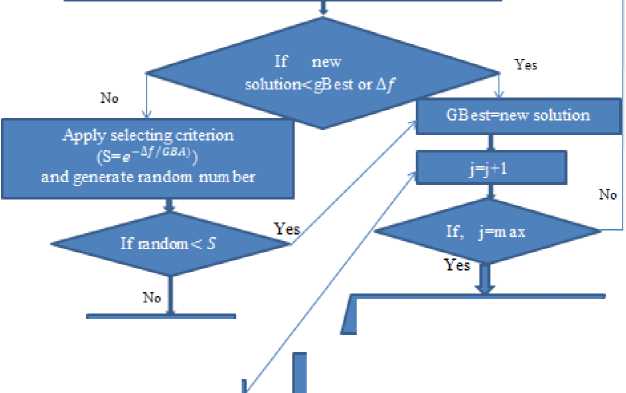
Get the updated solution
Reject the point
GBesF=previous solution
Update the position if require and checking local lea der lim it and global lea der lim it

Fig.1. Flow chart of proposed HSMOSA method
4. Simulation Result and Explanations
The CloudSimPlus simulator has been used to do simulations of the proposed HSMOSA algorithm. The Java programming language was required for the CloudSimPlus simulator. The performance metrics calculated during simulation are execution time, fitness value, throughput, mean, and standard deviation of the proposed HSMOSA algorithm. The performance, as mentioned earlier, indicators were calculated using varying numbers of tasks and iterations. Here, consider the 10, 50, 100, 150, and 200 no. tasks. Iterations values increase upwards from 100, 200, 400, 600, 800, and 1000. To demonstrate the feasibility of the proposed HSMOSA algorithm, compare it to the PSO-SA algorithm. Performance metrics are calculated for the proposed HSMOSA algorithm along with the PSO-SA algorithm in the context of resource provisioning. The simulation parameters required to implement the proposed HSMOSA are listed in Table 1.
The proposed HSMOSA method's performance is evaluated in seven dimensions: (i) execution time with a varying number of iterations, (ii) fitness value with a varying number of iterations, (iii) throughput with a varying number of iterations, (iv) mean and standard deviation with a varying number of iterations for task 50, (v) execution time with a varying number of tasks, (vi) fitness value with a varying number of tasks, and (vii) throughput with a varying number of tasks.
Fig. 2 shows the screenshot of the simulation result for a proposed HSMOSA algorithm on the CloudSimPlus simulator. This simulation result includes the fitness value, execution time, throughput, mean and standard deviation of the proposed HSMOSA algorithm at maximum iteration 1000 with 50 tasks.
Table 1. Simulation parameters considered in implementing the proposed HSMOSA approach
|
Type |
Parameters |
Value |
|
Tasks |
Number of tasks or size |
10-200 |
|
Number of iterations |
100-1000 |
|
|
Broker |
No. of brokers |
4 |
|
Data center |
No. of data centers |
2 |
|
Cloudlet Length |
Length of the task |
10,000 |
|
VM |
No. of VMs |
5 |
|
RAM |
512 MB |
|
|
Size |
10,000 |
|
|
Operating system |
Windows 10 |
|
|
Hosts |
MIPS |
1000 |
|
Storage |
10,00,000 |
|
|
RAM |
2048 MB |
|
|
Bandwidth |
10,000 |
SIMULATION RESULTS
Cloudlet
DC
Host
Host PEs
VM|VM PEs
CloudletLen
CloudletPEs
FinishTime|ExecTime
ID
1 2
SUCCESS SUCCESS SUCCESS SUCCESS SUCCESS SUCCESS
ID
ID
1 2
CPU
ID I CPU
bestfitness4.396377385034731E-5
0| 0|
3|
3| summaxfit
MI
10000 10000
CPU cores
0 0
0 0
0 0
20 I
20 I
bestfitness of proposed hybrid algorithm (HSMOSA):
bestfitness4.482495853691335E-5 - bestfitness of proposed hybrid algorithm bestfitness3.4324157341937255E-5 bestfitness of proposed hybrid algorithm bestfitness3.7404151860856555E-5 bestfitness of proposed hybrid algorithm bestfitnessS.0849181328180614E-5 bestfitness of proposed hybrid algorithm bestfitness3.9889903865331685E-5 bestfitness of proposed hybrid algorithm bestfitness2.7323897480736652E-5 bestfitness of proposed hybrid algorithm bestfitness3.871916986099818E-5 ;
summaxfit i (HSMOSA):
(HSMOSA):
summaxfit
(HSMOSA):
0.0015184981200822671
4.396377385034731E-5 0.001654990733848802
4.482495853691335E-5
0.0016679303021458053
summaxfit
(HSMOSA):
3.4324157341937255E-5
0.0016009853679493312
summaxfit
(HSMOSA):
3.7404151860856555E-5
0.002198720924177914
summaxfit
i (HSMOSA): summaxfit
4.045935020698809E-6
0.0018603958006409285
summaxfit
3.9889903865331685E-5
0.0012830123016677353
bestfitness of proposed hybrid algorithm (HSMOSA):
bestfitness3.198669353548924E-5
summaxfit
bestfitness of proposed hybrid algorithm (HSMOSA):
bestfitness4.1162426936692186E-5
bestfitness of execution time probability throughput per
proposed hybrid algorithm (HSMOSA):
summaxfit
2.7323897480736652E- 5 0.0015672467418709585
3.871916986099818E-5
0.0015358939815714907
3.198669353548924E-5
0.0020169589198979153
4.1162426936692186E-5
milliseconds :2000.0
mean:2.0169589198979154E-4
standard deviation:0.0018152630279081238
-
Fig.2. Screenshot of the simulation result of the proposed HSMOSA algorithm
Fig. 3 shows a screenshot of the PSO-SA algorithm's simulation result, including the fitness value, execution time, throughput, mean and standard deviation at maximum iteration 1000 with 50 tasks. This algorithm is implemented to show the comparison with the proposed HSMOSA algorithm.
4.824347747700767
4.460245371256502
4.052577403466136
SIMULATION RESULTS
|
|Cloudlet| |
Status | |
DC) |
Host | Host |
PEs | |
VM |
VM PEs |
CloudletLen| |
CloudletPEs| |
StartTime| |
FinishTime| |
ixecTime |
|
ID |
ID) |
ID|CPU |
cores 1 |
10 |
CPU cores) |
Hl) |
CPU cores| |
Seconds| |
Seconds| |
Seconds |
|
|
: 1 |
SUCCESS |
1) |
1) |
10 |
1 |
3- |
10000| |
3) |
0 |
201 |
20 |
|
: 2 |
SUCCESS |
1) |
2) |
10 |
2 |
3[ |
10000) |
3) |
0 |
201 |
20 |
|
3 |
SUCCESS |
1) |
3) |
10 | |
3 |
Я |
10000) |
3) |
0 |
201 |
20 |
|
4 |
SUCCESS |
1) |
4) |
10 |
4 |
3! |
10000) |
3) |
0 |
201 |
20 |
|
' 0 |
SUCCESS| |
1) |
0 | |
10 |
0 |
3i |
10000) |
3) |
0 |
401 |
40 |
|
5 |
SUCCESS |
1) |
0| |
10 |
0 |
4 |
10000) |
3) |
0 |
40) |
40 |
Random Position :-4.288038104049395,0.7176585922241303,0.2943180285590872,-4.9981842150942954,3.074469697582578
Random Position Cost :3281.7510836945416
-2.634270802319608
-5.635065712593781
ulvaluel,0030846301160836newdesignpoint0,8467257027686426
UlvalueD.15667688033569438newdesfgnpoint0,7907822885346523 ulvalue0.7059590733354775newdesignpoint2.038220345739111 uIvaluel.3270750209694633neivdesignpoint-4.660016209559776 ulvalue0.19812313127012837newdesignpoint-1.6220973394355713
globalBest Position :-0.5312788296218985,2.8858551980437537,-0.27125348335989496,-3.7095896251961733,-3.9786424932973663. best fitness through PSOSA algorithm: 0.6561308559478736
meanl value :0.06561308659478736 standard deviation:0.5905177793530864
execution time in milliseconds :60
throughput per milliseconds :166.66666666666566
-
Fig.3. Screenshot of the simulation result of the PSO-SA algorithm
The First performance dimension (execution time with a different number of iterations) is listed in Table 2. This shows the completion time of the proposed HSMOSA approach and the PSO-SA algorithm at various iterations. Task 50 involves the 100, 200, 400, 600, 800, and 1000 iterations. Compared to the PSO-SA algorithm, the suggested HSMOSA algorithm's execution time decreases with each iteration interval.
Table 2. The Execution time of the proposed HSMOSA algorithm along with the PSO-SA algorithm at different iterations
|
Number of Iteration |
Meta-Heuristic Techniques |
|
|
Proposed HSMOSA’s execution time (in milliseconds) |
PSO-SA’s execution time (in milliseconds) |
|
|
100 |
6 |
22 |
|
200 |
6 |
30 |
|
400 |
5 |
36 |
|
600 |
6 |
45 |
|
800 |
6 |
53 |
|
1000 |
5 |
60 |
Fig. 4 demonstrates the graphical representation of Table 2 (the execution time of proposed HSMOSA with PSO-SA under varying iterations). This graph is generated on the CloudSimPlus simulator. The following chart shows the minimal value of execution time of the proposed HSMOSA algorithm compared to the PSO-SA algorithm while the number of iterations increases.
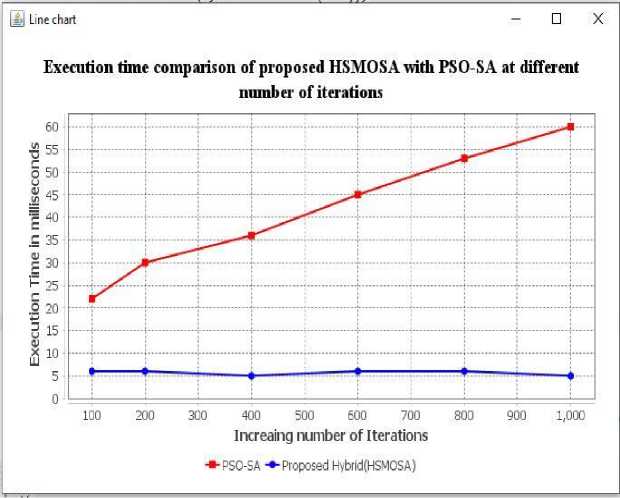
Fig.4. Execution time of the proposed HSMOSA algorithm with a different number of iterations
The second performance dimension (fitness value with various iterations) is listed in Table 3. It includes the 100, 200, 400, 600, 800, and 1000 number iterations with task 50. Fig. 5 is the graphical representation of Table 3. This graph is generated through simulation. Compared to the PSO-SA algorithm, the fitness value of the proposed HSMOSA algorithm is optimized at each iteration interval.
Table 3. The fitness value of the proposed HSMOSA algorithm along with the PSO-SA algorithm at different iterations
|
No. of iteration |
Proposed HSMOSA's fitness value |
PSO-SA's fitness value |
|
100 |
0.0163 |
2.9165 |
|
200 |
0.0199 |
2.0893 |
|
400 |
0.0090 |
0.8015 |
|
600 |
0.0236 |
0.3338 |
|
800 |
0.0230 |
0.3894 |
|
1000 |
0.0225 |
0.6561 |
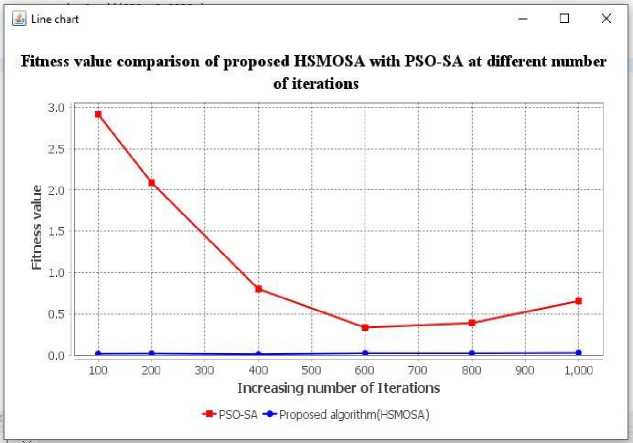
Fig.5. Fitness value of the proposed HSMOSA algorithm with a different number of iteration
The third performance dimension (throughput value with various iterations) is enlisted in Table 4. It includes the 100, 200, 400, 600, 800, and 1000 iterations with task 50. Table 4 shows that the throughput value of the proposed HSMOSA algorithm increases at each iteration interval compared to the PSO-SA algorithm. Fig. 6 demonstrates the graphical representation of Table 4. This graph is generated on the CloudSimPlus simulator.
Table 4. The throughput of the proposed HSMOSA algorithm along with the PSO-SA algorithm at different iterations
|
No. of iteration |
Proposed HSMOSA's throughput |
PSO-SA's throughput |
|
100 |
166.66 |
45.45 |
|
200 |
333.33 |
66.66 |
|
400 |
800.0 |
111.11 |
|
600 |
1000.0 |
133.33 |
|
800 |
1333.33 |
150.94 |
|
1000 |
2000.0 |
166.66 |
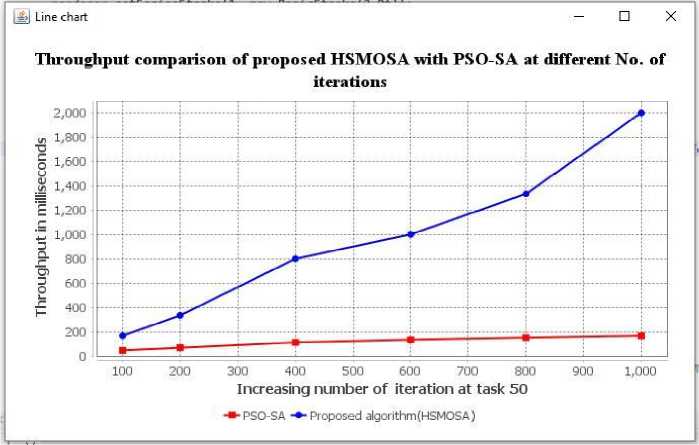
Fig.6. Throughput value of the proposed HSMOSA algorithm with different number of iteration
The fourth performance dimension (mean and standard deviation with different iterations for task 50) is listed in Table 5. It includes the 100, 200, 400, 600, 800, and 1000 iterations with task 50. It shows that the mean and standard deviation value of the proposed HSMOSA algorithm is minimized at each iteration interval compared to the PSO-SA algorithm.
Table 5. Mean and standard deviation value of proposed HSMOSA algorithm along with PSO-SA algorithm at different iterations
|
No. of Iteration |
Proposed HSMOSA Mean value |
PSO-SA Mean value |
Proposed HSMOSA Standard deviation value |
PSO-SA Standard deviation value |
|
100 |
0.0214 |
0.2916 |
0.0010 |
2.6248 |
|
200 |
0.0238 |
0.2321 |
0.0011 |
2.0893 |
|
400 |
0.0286 |
0.0801 |
0.0014 |
0.7213 |
|
600 |
0.0311 |
0.0333 |
0.0015 |
0.3004 |
|
800 |
0.0246 |
0.0389 |
0.0012 |
0.3505 |
|
1000 |
0.0257 |
0.0656 |
0.0012 |
0.5905 |
The fifth performance dimension (execution time under a varying number of tasks at iteration 1000) is enlisted in Table 6. It includes the 10, 50, 100, 150, and 200 numbers tasks at iteration 1000. Fig. 7 demonstrates the graphical representation of Table 6. This graph is generated on CloudSimPlus simulator. As the number of tasks rises, the suggested HSMOSA algorithm's execution time decreases compared to the PSO-SA algorithm.
Table 6. The Execution time of the proposed HSMOSA algorithm along with the PSO-SA algorithm at different tasks
|
Number of Tasks |
Meta-Heuristic Techniques |
|
|
Proposed HSMOSA’s execution time(in milliseconds) |
PSOSA’s execution time(in milliseconds) |
|
|
10 |
3 |
29 |
|
50 |
6 |
59 |
|
100 |
8 |
91 |
|
150 |
10 |
121 |
|
200 |
12 |
150 |
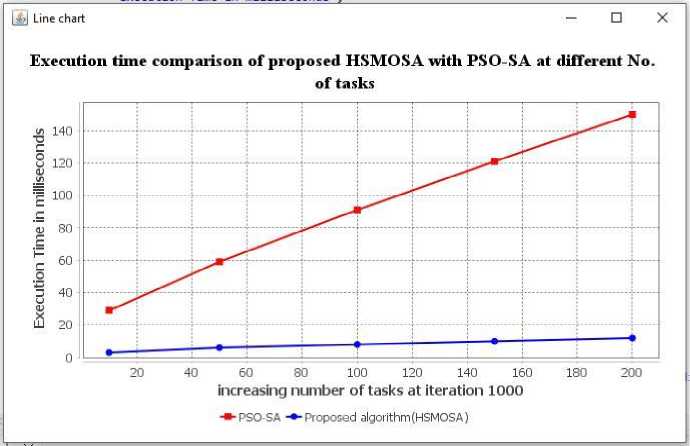
Fig.7. Execution time of the proposed HSMOSA algorithm with different numbers of tasks
The sixth performance dimension (fitness value under a varying number of tasks at iteration 1000) is mentioned in Table 7. It includes the 10, 50, 100, 150, and 200 numbers tasks at iteration 1000. Fig. 8 demonstrates the graphical representation of Table 7. This graph is generated on CloudSimPlus simulator. It demonstrates that the suggested HSMOSA algorithm has a better fitness value than the PSO-SA scheme as the number of tasks increases.
Table 7. The fitness value of the proposed HSMOSA algorithm along with the PSO-SA algorithm at different tasks
|
Number of Tasks |
Proposed HSMOSA's fitness value |
PSO-SA's fitness value |
|
10 |
0.0073 |
0.7399 |
|
50 |
0.0462 |
0.2719 |
|
100 |
0.0260 |
0.1392 |
|
150 |
0.0275 |
0.2512 |
|
200 |
0.0283 |
0.1141 |
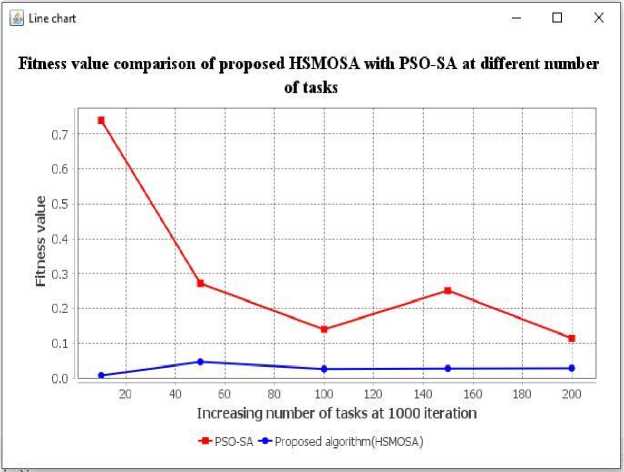
Fig.8. The fitness value of the proposed HSMOSA algorithm with different numbers of tasks
The last performance dimension (throughput value under a varying number of tasks at iteration 1000) is enlisted in Table 8. It includes the 10, 50, 100, 150, and 200 numbers tasks at iteration 1000. Fig. 9 demonstrates the graphical representation of Table 8. This graph is generated on CloudSimPlus simulator. Shows the throughput value increases of the proposed HSMOSA algorithm compared to the PSO-SA algorithm while the number of tasks increases.
Table 8. Throughput of proposed HSMOSA algorithm along with PSO-SA algorithm at different tasks
|
Number of Tasks |
Proposed HSMOSA's throughput |
PSO-SA's throughput |
|
10 |
333.33 |
344.82 |
|
50 |
1666.66 |
169.49 |
|
100 |
1250.0 |
109.89 |
|
150 |
1000.0 |
82.64 |
|
200 |
833.33 |
66.66 |
|^| Line chart — □ X
Tliroughput comparison of proposed HSMOSA with PSO-SA at different No. of tasks
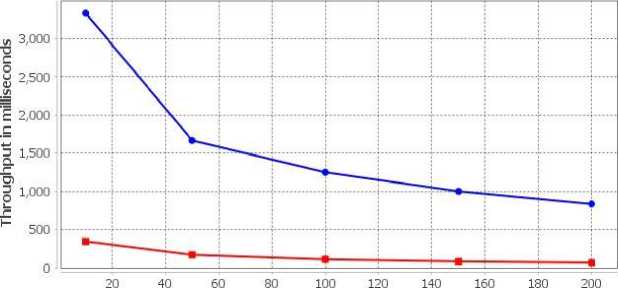
Increasing number of tasks at 1000 iteration
-•■PSO-SA -«-Proposed algorithm(HSMOSA)
Fig.9. Throughput value of the proposed HSMOSA algorithm with different numbers of tasks
5. Conclusions and Future Scope
This research provides a solution for dealing with resource provisioning issues in the cloud environment. Hybridization of spider monkey optimization with simulated annealing is a proposed HSMOSA method. The core goal of resource provisioning is to provide resources in the shortest time possible while maintaining optimal performance. Our proposed HSMOSA method overcomes resource provisioning problems and performs well. According to simulation results, the proposed HSMOSA approach allows for resource provisioning in the minimum possible time and increases throughput. While performing resource provisioning, the execution time of the proposed HSMOSA approach is 5 milliseconds and for PSO-SA is 60 milliseconds at iteration 1000 with task size 50, the execution time of the proposed approach minimizes 55% as compared to the PSO-SA approach, which shows the better working of proposed HSMOSA method. The proposed HSMOSA approach reached 2000 while PSO-SA has 166.66 (instructions per milliseconds) at iteration 1000 with task size 50, which demonstrates that the throughput of the proposed approach is also better as compared to PSO-SA. Results show that the proposed HSMOSA method fitness value optimizes, which helps improve the position of VMs and mean and standard deviation values minimize than the PSO-SA algorithm. According to the estimated performance characteristics (execution time, fitness value, throughput, mean, and standard deviation), the proposed method has a more significant impact in the cloud environment for provisioning resources. This proposed algorithm improves SMO and simulated annealing, so it can also applicable to those areas of cloud computing where optimization of resources is require. Integration of other nature-inspired techniques with improvements regarding the performance in other different parameters like cost, energy etc for resource provisioning as future perspectives.
Список литературы Hybrid Spider Monkey Optimization Mechanism with Simulated Annealing for Resource Provisioning in Cloud Environment
- Kumar, N., and Kumar, S., 'Virtual Machine Placement Using Statistical Mechanism in Cloud Computing Environment', In International Journal of Applied Evolutionary Computation, 2018, pp23-31.
- Srivastava, P., and Khan, R., 'A Review Paper on Cloud Computing', In International Journals of Advanced Research in Computer Science and Software Engineering, 2018, pp17-20.
- Vishal Kumar, Asif Ali Laghari, Shahid Karim, Muhammad Shakir, Ali Anwar Brohi,"Comparison of Fog Computing & Cloud Computing", International Journal of Mathematical Sciences and Computing, Vol.5, No.1, pp.31-41, 2019.
- Eawna, M., Mohammed S., and El-Horbaty, E., 'Hybrid Algorithm for Resource Provisioning of Multitier Cloud Computing', In International Conference on Communication, Management and Information Technology (ICCMIT), Elsevier, 2015.
- Seethalakshmi, V., Govindasamy, V., and Akila, V., 'Hybrid gradient descent spider monkey optimization (HGDSMO) algorithm for efficient resource scheduling for big data processing in heterogenous environment', Journal of Big Data 7, springer open, 2020, pp1-25.
- Addya, S., Turuk, A., Sahoo, B., Sarkar, M., and Biswash, S., 'Simulated annealing based VM placement strategy to maximize the profit for Cloud Service Providers', In Engineering Science and Technology, an International Journal, Elsevier, Vol. 20, Issue 4, 2017, pp1249-1259.
- Anozie Onyezewe, Armand F. Kana, Fatimah B. Abdullahi, Aminu O. Abdulsalami, "An Enhanced Adaptive k-Nearest Neighbor Classifier Using Simulated Annealing", International Journal of Intelligent Systems and Applications, Vol.13, No.1, pp.34-44, 2021.
- Kumar, M., Kishor, A., Abawajy, J., Agarwal, P., Singh A., and Zomaya, A., 'ARPS: An Autonomic Resource Provisioning and Scheduling Framework for Cloud Platforms', In IEEE Transactions on Sustainable Computing (Early Access), 2021, pp1 – 1.
- Bi, J., Yuan, H., Tan, W., Zhou, M., Fan, Y., Zhang, J., and Li, J., 'Application-Aware Dynamic Fine-Grained Resource Provisioning in a Virtualized Cloud Data Center', In Transaction on Automation Science and Engineering, IEEE, Vol. 14, 2015, pp1172 –1184.
- Cheng, D., Rao, J., Jiang C., and Zhou, X., 'Elastic Power-Aware Resource Provisioning of Heterogeneous Workloads in Self-Sustainable Datacenters', In IEEE Transactions on Computers, Vol. 65, Issue 2, 2016, pp508 – 521.
- Ma, X., Wang, S., Zhang, S., Yang, P., Lin C., and Shen, X., 'Cost-Efficient Resource Provisioning for Dynamic Requests in CloudAssisted Mobile Edge Computing', In IEEE Transactions on Cloud Computing, Vol. 9, Issue 3, 2021, pp968 – 980.
- Yu, H., Yang, J., and Fung, C., 'Fine-grained Cloud Resource Provisioning for Virtual Network Function', In IEEE Transactions on Network and Service Management, Vol. 17, Issue 3, 2020, pp1363 – 1376.
- Begam, R., Wang, W., and Zhu, D., 'TIMER-Cloud: Time-Sensitive VM Provisioning in Resource-Constrained Clouds', In IEEE Transactions on Cloud Computing, Vol. 8, Issue 1, 2020, pp297 – 311.
- Afrin, M., Jin, J., Rahman, A., Rahman, A., Wan, J., and Hossain, E., 'Resource Allocation and Service Provisioning in Multi-Agent Cloud Robotics: A Comprehensive Survey', In IEEE Communications Surveys & Tutorials, Vol. 23, Issue 2, 2021, pp842 – 870.
- Sharma, B., and Sharma, N., 'Accelerative Factor based Spider Monkey Optimization', In 9th International Conference on Computing, Communication and Networking Technologies (ICCCNT), 2018.
- Al-Azza, A., Al-Jodah A., and Harackiewicz, F., 'Spider Monkey Optimization: A Novel Technique for Antenna Optimization', In IEEE Antennas and Wireless Propagation Letters, Vol. 15, 2015, pp1016 –1019.
- Mumtaz, J., Guan, Z., Yue, L., Wang, Z., Ullah, S., and Rauf, M., 'Multi-Level Planning and Scheduling for Parallel PCB Assembly Lines Using Hybrid Spider Monkey Optimization Approach', In IEEE Access, Vol. 7, 2019, pp18685-18700.
- Chugh, A., Sharma, V., Kumar, S., Nayyar, A., Qureshi, B., Bhatia, M., and Jain, C., Spider Monkey Crow Optimization Algorithm With Deep Learning for Sentiment Classification and Information Retrieval', In IEEE Access, Vol. 9, 2021, pp24249 –24262.
- Mohammed Yousif, Ahmad Salim, Wisam K. Jummar," A Robotic Path Planning by Using Crow Swarm Optimization Algorithm ", International Journal of Mathematical Sciences and Computing, Vol.7, No.1, pp. 20-25, 2021.
- Bi, J., Yuan, H., Duanmu, S., Zhou, M., and Abusorrah, A., 'Energy-optimized Partial Computation Offloading in Mobile Edge Computing with Genetic Simulated-annealing-based Particle Swarm Optimization', In IEEE Internet of Things Journal, Vol. 8, Issue 5, 2021, pp3774 –3785.
- Xu, X., Cao, L., and Wang, X., 'Resource pre-allocation algorithms for low-energy task scheduling of cloud computing', In Journal of Systems Engineering and Electronics, Vol. 27, No. 2, 2016, pp457 – 469.
- Li, H., Wang, D., Zhou, M., Fan, Y., and Xia, Y., 'Multi-Swarm Co-Evolution Based Hybrid Intelligent Optimization for Bi-Objective Multi-Workflow Scheduling in the Cloud', In IEEE Transactions on Parallel and Distributed Systems, Vol. 33, Issue 9, 2022, pp2183 –2197.
- Wang, P., Xie, X., and Guo, X., 'Research on Resource Scheduling Algorithm for The Cloud', In International Conference on Intelligent Transportation, Big Data & Smart City (ICITBS), 2021.
- Wang, T., Zhang, Y., Xiong, N., Wan, S., Shen, S., and Huang, S., 'An Effective Edge-Intelligent Service Placement Technology for 5G-and-Beyond Industrial IoT', In IEEE Transactions on Industrial Informatics, Vol. 18, Issue 6, 2022, pp 4148 – 4157.
- Gabi, D., Dankolo, N., Muslim, A., Abraham, A., Joda, M., Zainal, A., and Zakaria, Z., 'Dynamic scheduling of heterogeneous resources across mobile edgecloud continuum using fruit fly-based simulated annealing optimization scheme', In Neural Computing and Applications, springer, 2022, pp1-21.
- Kalpana, P., Prabhu, S., Polepally, V., and Rao, J., 'Exponentially-spider monkey optimization based allocation of resource in cloud', In International Journal of Intelligent Systems, 2021, pp2521-2542.
- Tarawneh, H., Alhadid, I., Khwaldeh, S., and Afaneh, S., 'An Intelligent Cloud Service Composition Optimization Using Spider Monkey and Multistage Forward Search Algorithms', In Symmetry journal 14(82), 2022, pp1-18.
- Grabustsa, P., Musatovsa, J., and Golenkov, V., 'The application of simulated annealing method for optimal route detection between objects', In ICTE in Transportation and Logistics (ICTE), Vol. 149, 2019, pp95-101.

